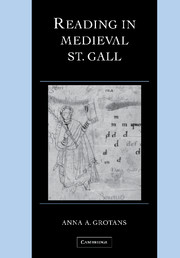Book contents
- Frontmatter
- Dedication
- Contents
- List of plates
- Acknowledgments
- List of abbreviations
- Manuscript punctuation and other symbols
- Introduction
- 1 Medieval reading
- 2 Education at ST. Gall
- 3 Language use and choice
- 4 The ST. Gall Tractate
- 5 Discretio in the classroom
- 6 Accentus
- 7 Spelling for reading
- Bibliography
- Index of manuscripts
- General index
5 - Discretio in the classroom
Published online by Cambridge University Press: 13 May 2010
- Frontmatter
- Dedication
- Contents
- List of plates
- Acknowledgments
- List of abbreviations
- Manuscript punctuation and other symbols
- Introduction
- 1 Medieval reading
- 2 Education at ST. Gall
- 3 Language use and choice
- 4 The ST. Gall Tractate
- 5 Discretio in the classroom
- 6 Accentus
- 7 Spelling for reading
- Bibliography
- Index of manuscripts
- General index
Summary
[C]onstrue scriptorum qui scis loca plura suorum. cernis inoffensos structura excedere sensus nullaque grammatices documenta uiro fore dices. comitis eximia probat id quoque lectio prima doctus et e cælis mage quam pede Gamalihelis ructat corde bonum sine lege Donatica uerbum.
The reading methodology outlined in the SGT was designed for training young lectores to analyze the grammatical and rhetorical structure of texts and to perform them orally according to sense. Notker adopted and further developed the same guidelines in his own translation/commentaries. Evidence from numerous construe marks, ordo-est glosses, and rearranged word order in commentaries attests that the practice was not new to St. Gall but was used throughout medieval European classrooms. Indeed, some of the possible exemplars and commentaries with which Notker worked contain guidelines for simplifying syntax. The St. Gall schoolmaster, however, did not borrow from his sources blindly nor indiscriminately, be it his exemplars or his own SGT methodology. He varied the traditional and prescribed “natural order” according to the passage at hand, taking into consideration the level of textual difficulty and pedagogic relevance as well as the text building strategies of the original. Sometimes the grammatical ordo naturalis is overshadowed by the ordo rerum, the order of thoughts, which can roughly be equated with functional sentence perspective or iconic word order. In a few instances Notker even combined the natural order of rhetorical/grammatical theory with the practical and – at least for his pupils – “natural” order of OHG.
- Type
- Chapter
- Information
- Reading in Medieval St. Gall , pp. 199 - 248Publisher: Cambridge University PressPrint publication year: 2006



